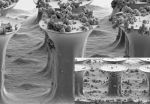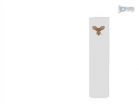(Press-News.org) The UK could generate almost half its energy needs from biomass sources, including household waste, agricultural residues and home-grown biofuels by 2050, new research suggests.
Scientists from the Tyndall Centre for Climate Change Research at The University of Manchester found that the UK could produce up to 44% of its energy by these means without the need to import.
The study, published in Energy Policy journal, highlights the country's potential abundance of biomass resources that are currently underutilised and totally overlooked by the bioenergy sector. Instead, say the authors, much of the UK bioenergy sector is heading towards increased reliance on biomass resources that will have to be imported from abroad.
Study author Andrew Welfle said: "The UK has legally binding renewable energy and greenhouse gas reduction targets, and energy from biomass is anticipated to make major contributions to these. The widely discussed barriers for energy from biomass include the competition for land that may otherwise be used to grow food and the narrative that biomass will have to be imported to the UK if we want to use increased levels of bioenergy. But our research has found that the UK could produce large levels of energy from biomass without importing resources or negatively impacting the UK's ability to feed itself."
The research involved analysing the UK's biomass supply chains and investigating how different pathways that the UK could take may influence the potential bioenergy that the country could generate from its own resources up to 2050.
The pathways the team analysed included a future with economic focus, investigating how the future UK bioenergy sector may look if economic growth was the prime focus; a conservation focus pathway, where the conservation of resources is the key future aim; an energy focus pathway, where the UK pushes towards achieving the maximum practical levels of bioenergy generated from its resources; and a food focus pathway, where the potential future of the country's bioenergy sector is analysed in reflection of the UK working to increase its food security.
"Biomass residue resources from ongoing UK activities, such as agriculture, forestry and industrial processes, were found to represent a continuous and robust resource option for the UK bioenergy sector, potentially contributing up to 6.5% of primary energy demand by 2050," said Mr Welfle. "The potential bioenergy generated from agricultural residues, particularly from straws and slurry resources, being the highlight opportunities for the bioenergy sector due to their high abundance and current underutilisation.
"UK waste resources were also found to represent a potential major opportunity for the bioenergy sector. The research highlights that both household and food/plant waste streams represent particular potential for the sector. Although the design and influence of future strategies and policies on UK waste generation and management are fundamental in determining the extent of opportunities that wastes represents to the UK bioenergy sector.
He added: "Biomass is a flexible energy option, in that it can be used to produce heat, electricity or even be converted to transport fuels, although different types of biomass resource tend to be utilised in specific ways in order to produce the most energy or biomass-based products with increased value. Our research confirms that the best option for the UK to make the most of its biomass resources would be for selected resources to be used by bio-refineries to produce high value bio-products, with all remaining suitable resources being dedicated for heat generation."
INFORMATION:
Notes for editors:
A copy of the paper, 'Securing a bioenergy future without imports,' is available on request.
UK failing to harness its bioenergy potential
2014-02-19
ELSE PRESS RELEASES FROM THIS DATE:
Making nanoelectronics last longer for medical devices, 'cyborgs'
2014-02-19
The debut of cyborgs who are part human and part machine may be a long way off, but researchers say they now may be getting closer. In a study published in ACS' journal Nano Letters, they report development of a coating that makes nanoelectronics much more stable in conditions mimicking those in the human body. The advance could also aid in the development of very small implanted medical devices for monitoring health and disease.
Charles Lieber and colleagues note that nanoelectronic devices with nanowire components have unique abilities to probe and interface with living ...
Gecko-inspired adhesion: Self-cleaning and reliable
2014-02-19
This news release is available in German. Geckos outclass adhesive tapes in one respect: Even after repeated contact with dirt and dust do their feet perfectly adhere to smooth surfaces. Researchers of the KIT and the Carnegie Mellon University, Pittsburgh, have now developed the first adhesive tape that does not only adhere to a surface as reliably as the toes of a gecko, but also possesses similar self-cleaning properties. Using such a tape, food packagings or bandages might be opened and closed several times. The results are published in the "Interface" journal of ...
Chemical leak in W.Va. shows gaps in research, policy
2014-02-19
The chemical leak that contaminated drinking water in the Charleston, W.Va., area last month put in sharp relief the shortcomings of the policies and research that apply to thousands of chemicals in use today. An article in Chemical & Engineering News (C&EN), the weekly magazine of the American Chemical Society, delves into the details of the accident that forced 300,000 residents to live on bottled water for days.
A team of C&EN reporters and editors note that the main chemical that leaked into the water supply is an obscure one called 4-methylcyclohexanemethanol, or ...
Advance in energy storage could speed up development of next-gen electronics
2014-02-19
Electronics are getting smaller all the time, but there's a limit to how tiny they can get with today's materials. Researchers now say, however, that they have developed a way to shrink capacitors — key components that store energy — even further, which could accelerate the development of more compact, high-performance next-gen devices. The study appears in the journal ACS Nano.
Takayoshi Sasaki and colleagues point out that many recent improvements have already downsized capacitors significantly. But current technology has almost reached its limit in terms of materials ...
Genetics linked to children viewing high amounts of violent media
2014-02-19
Washington, DC (February 19 2014) – The lifelong debate of nature versus nurture continues—this time in what your children watch. A recent paper published in the Journal of Communication found that a specific variation of the serotonin-transporter gene was linked to children who engaged in increased viewing of violent TV and playing of violent video games.
Sanne Nikkelen, Helen Vossen, and Patti Valkenburg of the University of Amsterdam's School of Communication Research, in collaboration with researchers at the Erasmus University Medical Centre in Rotterdam, analyzed ...
Special air filter blocks small particles called UFPs from getting inside cars
2014-02-19
While taking in the scenery during long road trips, passengers also may be taking in potentially harmful ultrafine particles (UFPs) that come into the car through outdoor air vents. Closing the vents reduces UFPs, but causes exhaled carbon dioxide to build up. Now, scientists report in the ACS journal Environmental Science & Technology that installing a newly developed high-efficiency cabin air filter (HECA) could reduce UFP exposure by 93 percent and keep carbon dioxide levels low.
Yifang Zhu and Eon Lee explain that most modern cars come with cabin air filters, but ...
Kinetic battery chargers get a boost
2014-02-19
New technology to capture the kinetic energy of our everyday movements, such as walking, and to convert it into electrical energy has come a step closer thanks to research to be published in the International Journal Biomechatronics and Biomedical Robotics.
Researchers have for many years attempted to harvest energy from our everyday movements to allow us to trickle charge electronic devices while we are walking without the need for expensive and cumbersome gadgets such as solar panels or hand-cranked chargers. Lightweight devices are limited in the voltage that they ...
A*STAR scientists discover protein's role in human memory and learning functions
2014-02-19
1. Scientists at A*STAR's Institute of Molecular and Cell Biology (IMCB) have identified the precise role of the protein, SNX27, in the pathway leading to memory and learning impairment. The study broadens the understanding of the brain's memory function and could be used to explain defects in the cognitive development of those with Down's syndrome. The newly established knowledge could potentially facilitate exploration of strategies to improve memory and learning abilities in Down's syndrome.
2. Down's syndrome is a genetic condition characterized by the presence ...
Could metabolism play a role in epilepsy?
2014-02-19
VIDEO:
The Kuehner lab demonstrates their drug-screening technique in JoVE's peer-reviewed video format to aid other researchers in the field.
Click here for more information.
February 19—Researchers from the Franciscan University of Steubenville, Ohio are exploring a possible link between metabolic defects and seizures. They determined that diet could influence susceptibility to seizures, and they have identified a common diabetes drug that could be useful in treating disorders ...
An essential step toward printing living tissues
2014-02-19
BOSTON — A new bioprinting method developed at the Wyss Institute for Biologically Inspired Engineering at Harvard University and the Harvard School of Engineering and Applied Sciences (SEAS) creates intricately patterned 3D tissue constructs with multiple types of cells and tiny blood vessels. The work represents a major step toward a longstanding goal of tissue engineers: creating human tissue constructs realistic enough to test drug safety and effectiveness.
The method also represents an early but important step toward building fully functional replacements for injured ...


